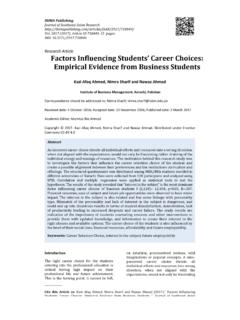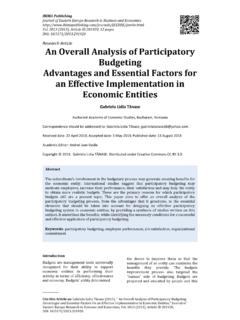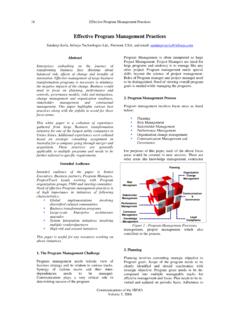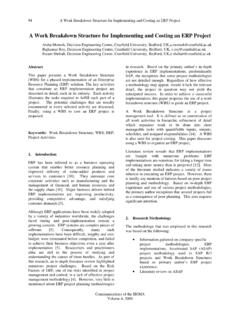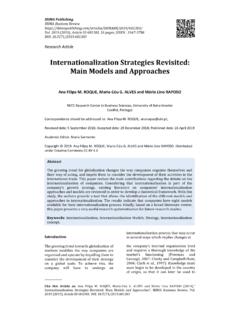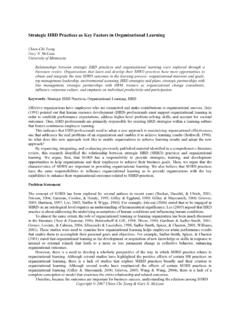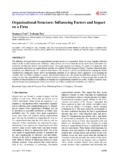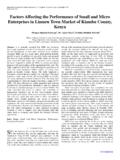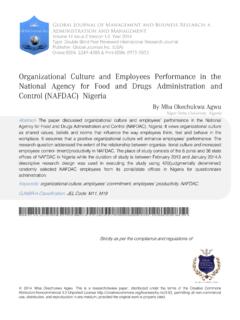Transcription of Research Article Factors that affect Employees Job ...
1 IBIMA Publishing Journal of Human Resources Management Research Vol. 2019 (2019), Article ID 354277, 23 pages, ISSN : 2166-0018 DOI: _____ Cite this Article as: Mohammd Abuhashesh, Rand Al-Dmour and Ra ed Masa deh (2019)," Factors that affect Employees Job Satisfaction and Performance to Increase Customers Satisfactions", Journal of Human Resources Management Research , Vol. 2019 (2019), Article ID 354277, DOI: Research Article Factors that affect Employees Job Satisfaction and Performance to Increase Customers Satisfactions Mohammd Abuhashesh1, Rand Al-Dmour2 and Ra ed Masa deh3 1E- Marketing and social Media Department, Princess Sumaya University for Technology (PSUT), Amman, Jordan 2,3 Management Information Systems, School of Business, the University of Jordan, School of Business Correspondence should be addressed to: Ra ed Masa deh; Received date: 28 September 2018; Accepted date: 14 February 2019; Published date: 12 April 2019 Copyright 2019.
2 Mohammd Abuhashesh, Rand Al-Dmour and Ra ed Masa under Creative Commons CC-BY Introduction While most people would agree that a job or an occupation is an essential part of life, individuals view work differently. Some people consider their job simply as a means to monetary compensation, while others consider it to be what defines their social status. We spend much of our time in the workplace; thus, we hope to find some Abstract In order to help the Jordanian industrial sector to minimize the amount of time and money currently spent on recruiting and training new Employees due to the rapid employee turnover rate, this study aims to identify the Factors which encourage Employees to remain in their jobs for a long-term as opposed to those that create negative sentiments thus, leading Employees to quit.
3 The Factors under focus are wages, organizational culture, benefits, job satisfaction, stress, training and development, promotion prospects, and job security. The study measures the impact of each factor on employee satisfaction. The Research population is the body of Employees in Jordan s industrial sector, with a random sample of industrial Employees representing the population. The quantitative method is used to examine the Research question. The study found that Jordanian Employees care the most about their salaries and position more than any other Factors . Therefore, we recommend that Jordanian manufactures consider studying the range of salary for each position, so they do not miss out on talented people or lose a good employee.
4 Keywords: Job Satisfaction; Employee Performance, Employee Satisfaction; Employee Turnover. Journal of Human Resources Management Research 2 _____ _____ Mohammd Abuhashesh, Rand Al-Dmour and Ra ed Masa deh (2019), Journal of Human Resources Management Research , DOI: personal interest and job satisfaction there since bringing the happiness and peace of mind is necessary to balance our personal lives and affects family and social relationships. From an employer s standpoint, it is in their interests to create a work environment where Employees feel motivated and encouraged to apply their full energies. The focus of this study is to identify the Factors that influence employee satisfaction and performance, with a view of helping business managers to attract, motivate and retain their Employees in the long term.
5 The term employee satisfaction describes the way an individual feels, thinks, and perceives his/her job, encompassing the positive and negative sentiments that influence the way an employee performs his/her work tasks. Employee satisfaction has a direct bearing on behavior in the workplace, with a good level of employee satisfaction improving the retention rate of Employees and minimizing recruiting and training expenses. Satisfied Employees perform their tasks better, and long-term Employees usually have a greater level of skill and expertise, both of which lead to increased performance. Since high employee satisfaction can be seen to lead to smooth operations in the workplace and result in higher profits, it is crucial for managers to understand the key Factors that increase employee satisfaction and, therefore, performance.
6 This study will potentially assist human resources departments and top management in Jordanian industry to focus their efforts on the Factors that most influence employee satisfaction which directly affect job retention and employee turnover. By studying the Factors of wages, organizational culture, benefits, stress, training and development, promotion system, and job security, we will be able to deduce the percentage of influence for each factor. A survey has been carried out among Jordanian industrial Employees to pinpoint the reality behind job satisfaction and high performance, also taking into account how the employee s age, education level, job position, and type of job affect attitudes toward work.
7 Literature Review Wages Previous studies by Frye (2004) show that there is a positive relationship between wages and employee performance and that income is the major factor of employee satisfaction. A survey by Nguyen et al. (2003) also showed that job satisfaction is positively affected by wages. These findings have been corroborated by numerous researchers (Cappelli & Sherer, 1988, Brown et al., 2008). Kathawala, Moore & Elmuti (1990) concluded that the salary system is the sole motivating factor for Employees in the automobile industry. They also state that compensations and rewards are important tools to control employee turnover rate. Hamermesh (2001) found that an increase in the salary has only temporary effects on employee satisfaction.
8 In the other hand, According to Wang & Seifert (2017), wages cut can affect Employees moral. Also, Employees performances tend to go to the wrong direction. Therefore, most of the companies during recession tend to lay off people instead of cutting payment. The roots of the payment for performance idea stems from a reinforcement theory which suggests that payment can be linked to employee performance. Heneman (1992) suggested that managers set target goals and reward Employees who meet them with a scheme of bonuses for achievement, consequently raising the overall performance. organizational Culture organizational culture can be defined as the set of characteristics that makes a company unique and distinguishes it from other companies, or as the way by which Employees within a company interact and the work environment that this interaction creates.
9 Researchers have expanded the 3 Journal of Human Resources Management Research _____ _____ Mohammd Abuhashesh, Rand Al-Dmour and Ra ed Masa deh (2019), Journal of Human Resources Management Research , DOI: definition of organizational culture, with Lee &Yu (2004) stating that it is the unique quality and organization style of a given workplace, while Abu-Jarad, Yusof, & Nikbin (2010) defined it as how things are done and dealt within an organization, as well as being a way for new Employees to gauge how to interact with colleagues. Alvesson & Spicer (2012) affirmed that culture encompasses a shared set of key values, understandings, assumptions, and norms among a company s Employees .
10 organizational culture can be viewed as the normative binding that holds the entire organization together (Tichy, 1982). organizational culture can have either a positive or a negative impact on employee motivation and performance. Previous studies had determined the relationship between culture and commitment. Y ld r m et al. (2016) found that positive culture increased the commitment of the Employees . Also, marketing culture can influence the performance of the Employees (Al- Mohammad, 2014). A successful culture encourages Employees to perform their work tasks with energy and enthusiasm. The more encouraging and positive the culture, the greater the job satisfaction, the level of commitment and the consequent efforts expended by Employees .
